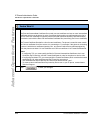
Advanced Operational Features
41-001160-00, Release 2.1, Rev 04 6-27
Configuring Advanced Operational Features
Advanced Operational Features
Symmetric UDP Signaling
By default, the IP phones use symmetric UDP signaling for outgoing UDP SIP
messages. When symmetric UDP is enabled, the IP phone generates and listens
for UDP messages using port 5060.
You can manually disable symmetric UDP signaling using the IP phone’s
configuration file. When you disable symmetric UDP signaling, then the IP phone
chooses a random source port for UDP messages.
The IP phone also chooses a random source port for UDP messages if you
configure a backup proxy server, registrar server, or outbound proxy server.
An Administrator can configure symmetric UDP signaling using the configuration
files only.
Configuring Symmetric UDP Signaling Using the Configuration Files
You use the following parameter to enable or disable Symmetric UDP Signaling
in the configuration files:
• sip symmetric udp signaling
Configuration Files
For the specific parameter you can set in the configuration files, see Appendix A, the section, “RTP, Codec,
DTMF Global Settings” on page A-77.


















